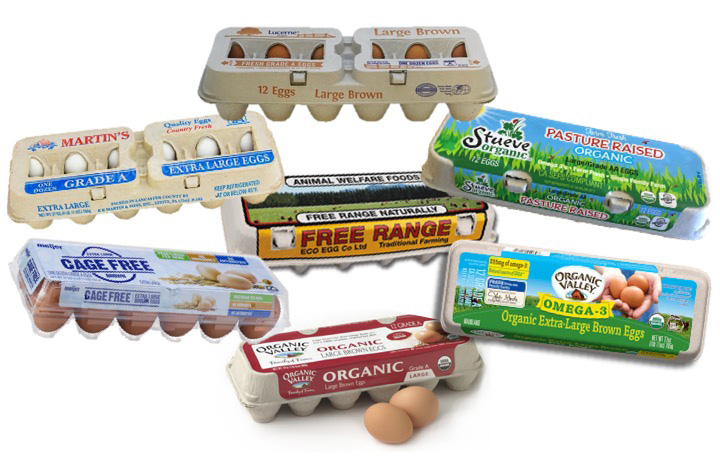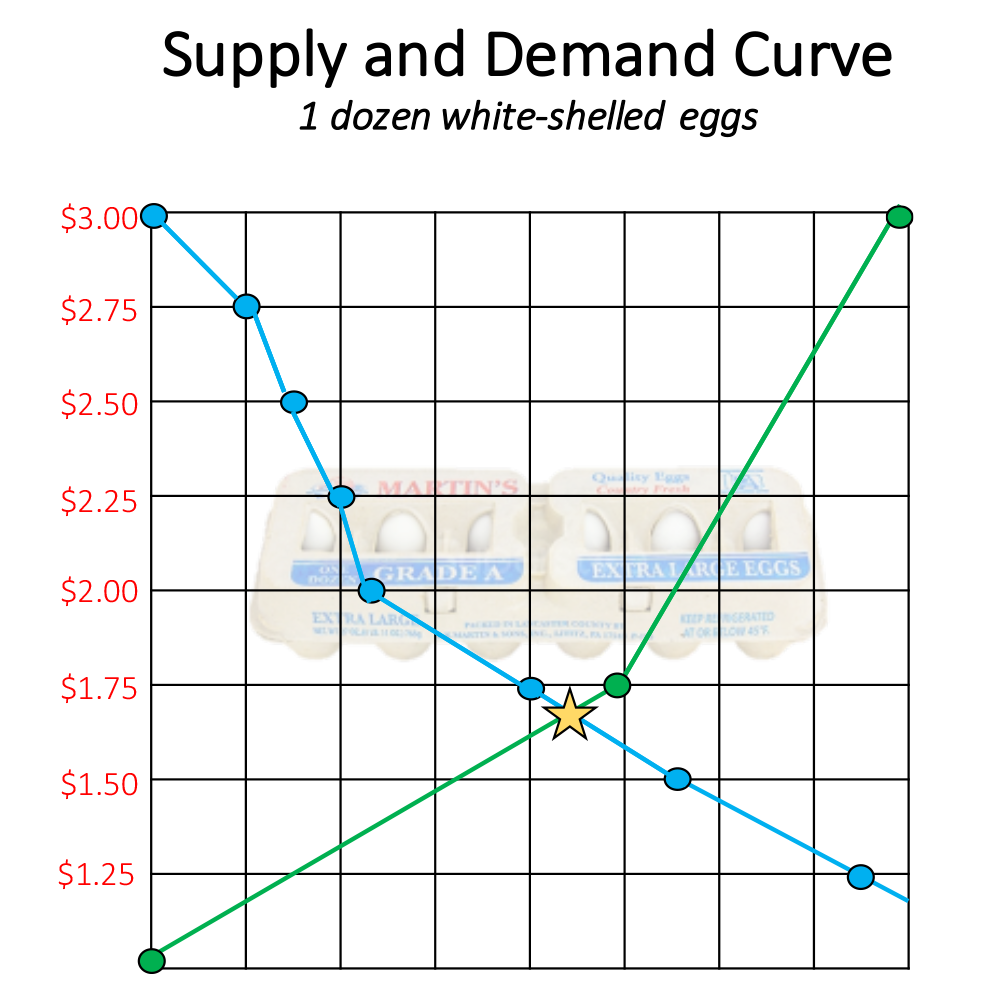Agricultural Literacy Curriculum Matrix
Lesson Plan
Weighing in on Egg Labels, Supply, and Demand
Grade Level
Purpose
Students will apply a basic understanding of the laws of supply and demand, learn about different types of egg laying farms, and recognize the impact labeling has on consumer choices. Grades 9-12
Estimated Time
Materials Needed
Engage:
- Video Quote Cards, 1 copy per class
- Video: Supply and Demand: Crash Course Economics #4
Activity 1: Weighing in on Egg Labels
- Egg Labels and Marketing PowerPoint slides
- Cracking the Egg Code Fact Sheet (1 copy per student or pair of students)
Activity 2: History and Introduction to the Egg Industry
- Eggs 101 - Barns
- Eggs 101 - Hen Health
- Video Quote Cards (from the Engagement activity)
Activity 3: Marketing Eggs
- Egg Labels and Marketing PowerPoint slides (continued from Activity 1)
Vocabulary
gallus domesticas: the scientific name for the domestic chicken often raised for meat and/or eggs
mortality: death or loss of life
selective breeding: process by which humans control the breeding of plants or animals in order to exhibit or eliminate a particular characteristic
Did You Know?
- As of March 2019, organic and cage-free shell egg production accounted for 18.3% of the current table egg layer flock. Of this, 4.7% are organic (14.6 million hens) and 8.5% are cage-free (26.6 million hens).1
- The top egg producing states are Iowa, Indiana, and Ohio.2
- The U.S. produces about 75 billion eggs per year, about 10% of the world supply.3
Background Agricultural Connections
Most people of the world eat the egg of the chicken, Gallus domesticas. Nearly 200 breeds and varieties of chickens have been established worldwide. Most laying hens in the U.S. are Single-Comb White Leghorns. Since birds and eggs preceded man in the evolutionary chain, they’ve existed longer than historians. East Indian history indicates that wild fowl were domesticated as early as 3200 B.C. Egyptian and Chinese records show that fowl were laying eggs for man in 1400 B.C. Europe has had domesticated hens since 600 B.C.
History of Egg Farming4
In the 1920s and 1930s, egg farms were still mostly backyard systems. Many farmers had laying hens to supply their own families with eggs and would sell any extra eggs at local farmers’ markets. As selling eggs became profitable, some farms started building up flocks of about 400 hens. The hens roamed around outside with a coop for roosting. Living outside presented some problems, mainly with weather and predators. Social issues within the flock such as the “pecking order” were also a problem because bigger and more aggressive birds would eat more of the food, leaving less for the other birds. Diseases were a problem, but selective breeding helped to cultivate healthier flocks. The strongest, healthiest birds with good egg-laying records were chosen by hatcheries to be parents. These parents passed along favorable genetic factors, such as disease resistance, to their offspring.
Research on moving hens to indoor living showed many benefits. While they were expensive, specialized large hen houses resulted in much healthier birds. When living indoors, the hens weren’t exposed to predators and the elements, including temperature extremes. Indoor housing also helped to prevent parasite infestations and reduce the spread of diseases from outside carriers, including rodents and even humans. Instead of the hens eating whatever they found outside, feed could be better controlled indoors. Better feeding practices improved both hen health and egg productivity. These changes reduced hen mortality to 18 percent a year.
In the late 1940s, some poultry researchers had favorable results with raised wire-floor housing for hens. The separated wire housing came to be called the cage system, and California farmers quickly put the research into practice. Sanitation greatly improved when hens were raised off the floor. Neither the hens nor the eggs came into contact with waste, and waste removal was much easier. Feeding became more uniform as the more timid hens were able to eat and drink as much as they required, just like the more aggressive hens. This resulted in more uniform egg-nutrient quality and less feed being needed for the flock.
The scientific research on caging proved itself in California. A healthy hen will lay a lot of eggs. With much improved health, California hens each produced about 250 eggs per year and their mortality dropped to 5 percent. Based on these numbers, more and more farms across the country built new facilities with the cage style of housing. Improving the health of hens through more protective housing and better feeding facilities led to more eggs which led to increased automation to handle the eggs. With increased automation, labor costs were reduced, providing a lower cost to the consumer. In addition to much improved hen health, equal-opportunity feeding also made the nutrient quality of eggs more uniform.
Egg Markets and Labeling
The marketing chain begins at the laying farm where eggs are gathered, packed, and refrigerated. On many farms, the grading and packing are done on the farm. At other farms, eggs are picked up several times a week by the grading station’s refrigerated trucks. At the grading station, the eggs are washed, sorted by size, graded for quality and packed into cartons. Ideally, eggs move from the grading station to the store or store warehouse three to five times a week, depending on available storage space. Many large supermarket chains receive all their eggs at warehouses from which the eggs are distributed to individual stores.
Eggs are laid by all types of birds, but chicken eggs are the most consumed egg. Chickens are cost-efficient to raise and can produce approximately one egg per day during their peak production. Egg shells can be white, brown (light or dark), and even a light shade of green or blue. The shell color is determined by the breed of the chicken laying the egg. White shelled eggs are most common in the United States because White Leghorns are the most common breed of chicken to raise for egg laying due to their egg producing capacity and their smaller size when compared to other breeds of chickens. It is common for brown-shelled eggs to cost more than white eggs. It costs farmers more to produce brown-shelled eggs due to the size difference in the birds. Larger birds require more feed, but don't produce more eggs. As a result, brown-shelled eggs typically cost more than white-shelled eggs.
On egg farms, several types of hen housing systems are utilized. These systems include conventional, cage free, free range, and enriched colony housing. Common to each system is continuous access to feed, water, and fresh air. All eggs, regardless of the type of farm they were produced on, provide the same level of nutrients to our diet.5 Egg farming has changed through the years as farmers have sought to produce a safe, nutrient rich, and economical food product for consumers. Eggs produced on farms with cage-free or free range housing systems are typically more expensive due to increased production costs over eggs produced in conventional style housing.
Engage
- Print one classroom copy of the Video Quote Cards. Hold them up or attach them to the board for students to see. Ask students to draw on their prior knowledge about economics and marketing to try to explain what the quotes mean and to give examples that illustrate the theme of each quote.
- After students have offered their prior knowledge and ideas, show the first 7 minutes and 16 seconds of Supply and Demand: Crash Course Economics #4. (Stop just after the example of gasoline prices.)
- After watching the video clip, ask students the following questions:
- What is a market? (any place where buyers and sellers meet to exchange goods and services.)
- What is the concept of voluntary exchange? (buyers and sellers willingly decide to make a transaction.)
- What is an equilibrium price and quantity? (Where the supply and demand curve meet.)
- Refer back to the video quotes from step one and show students the image below of various egg cartons. Ask students what type of labels they notice on the egg cartons and how each of these labels can impact the marketing (supply and demand) of eggs. Students should note specific phrases on the labels such as brown eggs, cage free, omega 3, organic, pasture raised, and free range. Ask students what they think these labels mean and how they impact the supply and demand for eggs in the United States.

Explore and Explain
Activity 1: Weighing in on Egg Labels
- Project the Egg Labels and Marketing PowerPoint.
- Ask students to picture the egg department at the grocery store (slide 2) and imagine that they are determining the value of various cartons of eggs. Perform a survey with your class using slides 3-11. Students will guess which carton of eggs will likely cost more and then determine which eggs they would choose in the role of a consumer. Accept any answers and note trends in your students' choices. (i.e., If the majority of the class always chooses the cheapest option, if students seem to prefer brown eggs over white eggs, etc.) Intermittently, allow students to share reasoning behind their choice.
- After the survey, ask students, "How can marketing, such as a label on an egg carton, impact buying choices?" (to some consumers, the labels could persuade them to purchase one carton of eggs over another and/or be willing to pay more for an egg labeled in a specific way.)
- Give each student one copy of the Cracking the Egg Code Fact Sheet.
- Allow students time to read through the infographic learning the definition of each egg label in preparation for the next activity.
- Using PowerPoint slide 12, review some basic economic principles of egg production:
- Brown shelled eggs typically cost more than white shelled eggs because the breeds of chicken that lay brown eggs are typically bigger and eat more feed, but do not lay more eggs.
- White eggs produced in conventional style housing are typically the cheapest because that is the most cost effective way to produce eggs.
- Eggs produced in cage-free or free range housing systems cost more because these housing systems have higher production costs to the farmer.
| All eggs, regardless of the color of the shell or the type of farm they were produced on, provide the same level of nutrients to our diet.5 |
Activity 2: History and Introduction to the Egg Industry
- Ask students if they believe that egg farming has changed in the last 100 years. Explain that 100 years ago many families produced their own eggs. Progressively, egg-laying hens moved out of backyards and onto farms. These farms have increased in size and technological advancements through the years.
- Watch the Eggs 101- Barns video clip. This 3-minute video clip gives an overview for how hen housing systems have evolved and the types of hen housing systems that exist today.
- As the students watch the video, have them list the goals egg farmers have as egg farming evolved:
- Provide high quality, nutritious, and economical eggs for consumers.
- Protect hens from weather and predators.
- Decrease diseases and parasites in the flock.
- Access to fresh feed, water, light, and sanitary conditions.
- Watch the Eggs 101 - Hen Health video clip. As students watch the video clip, they should take note of things that are important to consumers in the market to buy eggs. (Humane animal care standards, healthy eggs free from salmonella, etc.)
- Refer back to the video quotes from step one of the Interest Approach. Discuss how farmers have followed these principles as egg farming practices have evolved. Examples include:
- Consumers would like eggs that are safe (free of foodborne illness like salmonella) and consistent in nutrition. Egg markets encouraged farmers to find ways to provide this for consumers by improving hen health and nutrition.
- Due to voluntary exchange, farmers would go out of business if they produced eggs that did not benefit the consumer by providing a safe and nutritious food item. As farmers produce quality and nutritious eggs, consumers benefit, and both are better off.
- As consumers choose which eggs they buy (white, brown, free range, etc.) it signals to farmers what kind of eggs to produce. If 90% of consumers choose the most economical egg (white shelled eggs from a conventional egg farm), then the majority of farmers will continue to produce these eggs. If there is a market for brown or cage-free eggs, farmers will produce these eggs.

Activity 3: Marketing Eggs
- Ask students, "How are market prices for eggs (or any product) determined?" (Market prices are where supply and demand meet. Remind students of the video clip they watched at the beginning of the lesson)
- Open the Egg Labels and Marketing PowerPoint and project slide 13 onto your whiteboard. Inform your students that you are going to graph a demand curve for your class. Ask your students to raise their hand if they would pay $3.00 for 1 dozen conventional, white-shelled eggs. Count how many students raise their hand and place a dot on the graph. Next, ask how many students would pay $2.75 for 1 dozen conventional white-shelled eggs. Graph that number and continue down the left side of the graph until you have asked about each price of egg. Connect the dots to create a demand curve for your class.
- Without erasing your whiteboard, proceed to slide 14 and discuss what a supply curve represents. (The number of producers willing to sell eggs for a given price.) Be sure students understand that farmers make economical decisions. To stay in business, they must sell their product for more than it cost them to produce it. A conventional egg farmer must consider the cost of buying and raising hens, buying feed, purchasing and maintaining their hen housing and egg processing equipment, etc. Compared to other methods of raising hens for egg production, conventional eggs are the most economical.
- Add a demand curve to the graph. Have students identify the current cost at a local grocery store for one dozen white-shelled, conventional eggs. For this discussion, make this price the market equilibrium. Complete the demand curve with hypothetical numbers to show that most (or all) farmers will produce and sell their eggs at a high cost and few farmers will produce and sell eggs at a very low cost.
- Using slides 15 and 16 repeat the same process (steps 2-4) with the brown-shelled, free range eggs. Most likely, fewer students will be willing to pay the higher premium for free-range eggs. Currently this marketing pattern is also evident in the general consumer population. As a result, more eggs are produced on conventional egg farms than free-range farms. Farmers will continue to produce eggs (and other products) according to demand.

| Remind students that shell color is determined by the breed of hen. Hens who lay brown eggs are larger and require more feed than hens who lay white eggs. This increases the production cost of brown eggs. The nutritional value of each egg, regardless of the shell color or retail price, is equivalent. |
Elaborate
-
Give students a video tour of Burnbrae Farms, a large egg farm in Canada with several styles of hen-housing. Have students watch each video and compare and contrast the benefits and disadvantages for each housing system in a T-chart. After completing the activity, students should recognize that when accounting for all factors there is no single "best" or "worst" system. Each producer and consumer chooses their preference according to the market equilibrium for each style of egg production.
-
For an additional lesson to provide further content on these economic and marketing principles, see Supply and Demand: What If?
-
Discuss how marketing impacts the decisions consumers make regarding their diet and health. Could the higher price of brown-shelled eggs, or eggs produced in a free-range or cage-free facility lead some consumers to believe that the actual egg contains more or better nutrients? Does the influence of family, peers, and media impact consumer choices and perceptions? Discuss ideas about how these misconceptions could be eliminated.
-
Explore statistics for egg sales. Compare prices and evaluate the most common consumer choices in regards to hen housing practices.
-
Now that students have a foundational knowledge of various egg production practices and their associated labels, challenge students to design an egg carton for an egg farmer. Students should determine which type of production system they will choose (conventional, cage free, organic, etc.) based upon the level of demand they determine can be found.
Evaluate
After conducting these activities, review and summarize the following key concepts:
- Farmers provide the supply and consumers provide the demand for agricultural products such as eggs.
- Change in cultural preferences impact production processes in agriculture. For example, if more consumers create a demand for cage-free or free-range eggs, more farmers will adopt this production style. If most consumers still prefer lower-cost eggs from conventional style egg production, the majority of egg production will remain conventional.
- Food labeling affects consumer choices.
Sources
- https://www.incredibleegg.org/about-us/industry-data
- https://www.incredibleegg.org/about-us/?site=a
- https://www.aeb.org/farmers-and-marketers/industry-overview/31-farmers-marketers
- https://www.incredibleegg.org/about-us/us-egg-farming-history?site=a
- http://content.time.com/time/health/article/0,8599,2002334,00.html
Recommended Companion Resources
Author
Organization
| We welcome your feedback! If you have a question about this lesson or would like to report a broken link, please send us an email at [email protected]. If you have used this lesson and are willing to share your experience, we will provide you with a coupon code for 10% off your next purchase at AgClassroomStore. |
